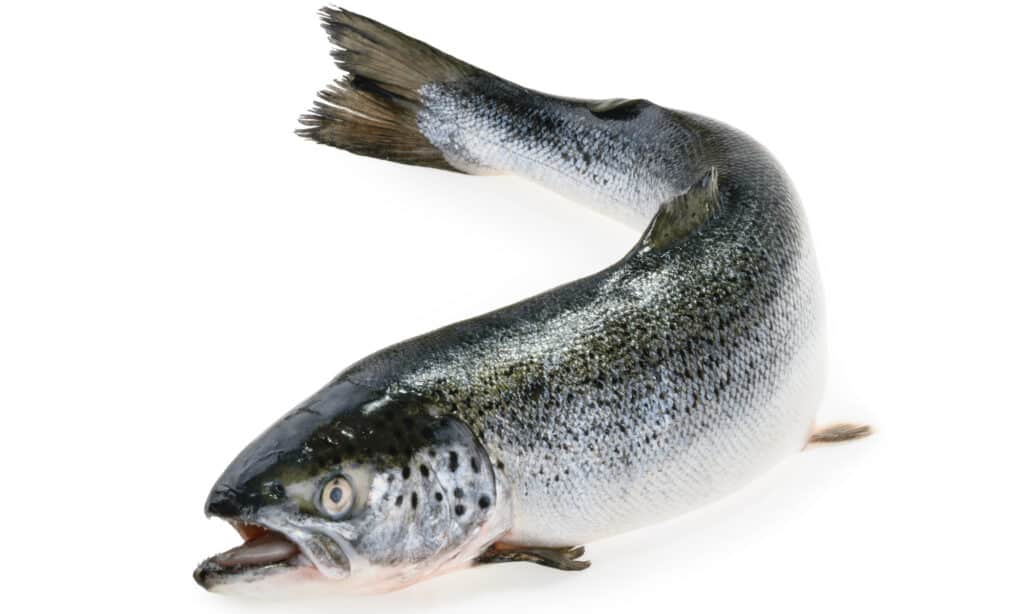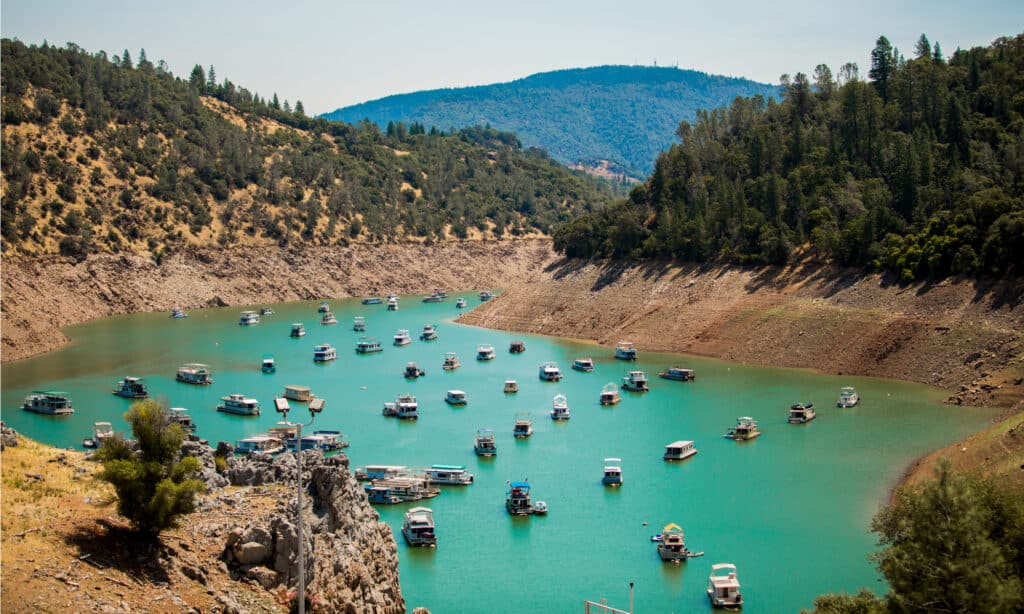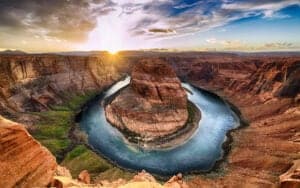What is the Oroville Dam and Why is it So Huge?
@media (min-width: 481px) {
.mobile-top-content {
display: none;
}
}
#mobileTopContentCTACarouselControls { overflow: hidden; text-overflow: ellipsis; white-space: nowrap; }
.mobile-top-content .more { color: #fff; }
.mobile-top-content a { color: #fff; text-decoration: underline; }
.mobile-top-content a:hover { color: #fff; text-decoration: underline; }
@media (max-width: 480px) {
.mobile-top-content {
background-color: #06a10b;
color: #fff;
text-align: center;
/*height: 60px;
padding-top:5px;*/
font-size:80%;
/* display: block; */
margin: 0px -30px;
}
}
The Oroville Dam is located in California, and it’s the tallest dam in the United States at a towering 770 feet. The dam creates Lake Oroville, which is the second biggest reservoir in the state of California. It’s northeast of Sacramento in the foothills of the Sierra Nevada.
In a part of the state that fluctuates between extreme flood conditions and devastating droughts, reservoirs like the Oroville Dam are vital because they regulate water during these events. However, their crumbling infrastructure and climate change are quickly taking their toll.
We’re going to discuss more information defining what the Oroville Dam is, as well as discuss why it’s so huge. Then we’ll discuss wildlife near the Oroville Dam and go over the safety of the dam. Let’s get started!
What is the Oroville Dam?

iStock.com/OwensImaging
The Oroville Dam is an earthfill dam. An earthfill dam is made of a core of compacted earth or cement. When dirt is chosen for this, the composition of the dirt is carefully considered to make sure the core is impermeable. At the Oroville Dam, the core is made of special concrete that is also impenetrable to water.
The core is covered with gravel and sand called rockfill materials. There have been studies on which rockfill materials are appropriate, as their exact composition in comparison to the local soil is something that needs to be considered.
The Oroville Dam controls the Feather River. Released water travels down the river and connects to the Sacramento River before it enters the Sacramento-San Joaquin Delta. From there, water is diverted into the California Aqueduct.
The California Aqueduct takes water south of Los Angeles, and a drop of water that deposits into Lake Oroville travels the aqueduct for ten days before it reaches the end of it.
Why is the Oroville Dam So Huge?

Joe Woods/Shutterstock.com
The Oroville Dam is so huge because it needs to hold back floodwaters in a critical location along California’s naturally complex watercourses. Since the dam is at the base of the mountains right where the forks of the feather river converge in a steep canyon, it was a great place to construct a dam. This was to gain control over huge quantities of needed freshwater at a location that provides a deep reservoir right where it’s needed. It’s so tall because it could be based on the local geography.
The floods that were happening on the Feather River were so bad that they were causing millions in damage every few years. The water demands of an arid state also required radical action to correct, and the construction of the Oroville Dam was a big response to a big problem.
Why Was the Oroville Dam Constructed?
The Oroville Dam was constructed to control floodwaters during wet winters and provide stored water during droughts.
The California Department of Water Resources built the dam during the establishment of the statewide water system. Construction began in 1961, was finished in 1967, and the dam began to be used in 1968.
The Oroville Dam is also a large producer of electricity, and it began being used in this capacity as soon as the dam was operational. It provides invaluable flood control for the Sacramento Valley and is vital in providing irrigation for agriculture in the San Joaquin Valley south of the Sacramento Valley.
Coastal Southern California needed a solid municipal water supply, and the Oroville Dam rectified that situation. The California Aqueduct, which wouldn’t be possible without the Oroville Dam in Northern California, is the main reason that California can support Los Angeles and create the bed basket of the world in its huge valley.
Wildlife and the Oroville Dam

azure1/Shutterstock.com
Wildlife has been negatively affected by the construction of the dam. Since the dam blocks the natural watercourse and flow of the Feather River, it has created a deterioration of the natural habitat along its banks.
Sediment from the watershed above the river now doesn’t make it into the river system that continues beyond the dam. It gathers in the lake, causing problems and leading to the degradation of habitat down the river. This is affecting both fish and plant life.
Fish are also unable to travel the length of the river, which affects fish populations downstream. As with other California dams, the Oroville Dam now has an accompanying fish hatchery to help address the situation.
The two fish of most concern are the steelhead trout and the Chinook salmon. Their migration is completely blocked by the Oroville Dam.
Before fish reach the unpassable part of the river, they are redirected up a fish ladder into a hatchery. The hatchery endeavor has done so well that there are now concerns that the hatchery’s fish are pushing out the wild fish in their natural habitat.
So much concern is directed toward steelhead trout and Chinook salmon because they make up 20% of these fish types caught in the Pacific Ocean. This 20% accounts for both hatchery spawned and wild populations.
Lake Oroville is also home to catfish, sturgeon, bass, crappie, mackinaw, and bluegill. The elderberry shrubs found along the lake are home to longhorn beetles, which are a threatened species. There are rules in place about the proximity of pesticides to elderberries to preserve these beetles’ habitat.
Is the Oroville Dam Safe?

Salvadorxrodriguez/Shutterstock.com
The Oroville Dam is safe for now. It has undergone recent inspections that approved repairs to infrastructure that were long overdue.
Because a 100-year storm rolled in during the 2016-2017 winter in California, the earthen spillway from the 1960s was used for the first time because the main concrete spillway eroded and became unsafe. Unfortunately, the dirt emergency spillway started eroding the dirt underneath it, and there was a deep fear that the entire embankment would come down.
There have been concerns about the safety of the aging earthen dam for years, and in 2017, the situation escalated into a crisis. Over 180,000 residents were evacuated due to the erosion of the vital spillway, which threatened to send a wall of water downstream.
Before then, concerns had been raised about cracked spillways, broken valves, and other maladies that should have been addressed as they arose. Since the 2017 event, major construction has occurred on the dam, so this situation will be avoided in the future.
FAQs (Frequently Asked Questions)
What is the largest dam on Earth?
The largest manmade dam on Earth is the Jinping-I Dam in China, which measures 1,0001 feet tall. The largest natural dam in the world is the Usoi Dam in Tajikstan, which is 1,860 feet tall.
More from A-Z Animals
.more-snake-card-image { max-height:140px !important; }
@media (min-width: 481px) {
.mobile-top-content {
display: none;
}
}
#mobileTopContentCTACarouselControls { overflow: hidden; text-overflow: ellipsis; white-space: nowrap; }
.mobile-top-content .more { color: #fff; }
.mobile-top-content a { color: #fff; text-decoration: underline; }
.mobile-top-content a:hover { color: #fff; text-decoration: underline; }
@media (max-width: 480px) {
.mobile-top-content {
background-color: #06a10b;
color: #fff;
text-align: center;
/*height: 60px;
padding-top:5px;*/
font-size:80%;
/* display: block; */
margin: 0px -30px;
}
}
The Oroville Dam is located in California, and it’s the tallest dam in the United States at a towering 770 feet. The dam creates Lake Oroville, which is the second biggest reservoir in the state of California. It’s northeast of Sacramento in the foothills of the Sierra Nevada.
In a part of the state that fluctuates between extreme flood conditions and devastating droughts, reservoirs like the Oroville Dam are vital because they regulate water during these events. However, their crumbling infrastructure and climate change are quickly taking their toll.
We’re going to discuss more information defining what the Oroville Dam is, as well as discuss why it’s so huge. Then we’ll discuss wildlife near the Oroville Dam and go over the safety of the dam. Let’s get started!
What is the Oroville Dam?

iStock.com/OwensImaging
The Oroville Dam is an earthfill dam. An earthfill dam is made of a core of compacted earth or cement. When dirt is chosen for this, the composition of the dirt is carefully considered to make sure the core is impermeable. At the Oroville Dam, the core is made of special concrete that is also impenetrable to water.
The core is covered with gravel and sand called rockfill materials. There have been studies on which rockfill materials are appropriate, as their exact composition in comparison to the local soil is something that needs to be considered.
The Oroville Dam controls the Feather River. Released water travels down the river and connects to the Sacramento River before it enters the Sacramento-San Joaquin Delta. From there, water is diverted into the California Aqueduct.
The California Aqueduct takes water south of Los Angeles, and a drop of water that deposits into Lake Oroville travels the aqueduct for ten days before it reaches the end of it.
Why is the Oroville Dam So Huge?

Joe Woods/Shutterstock.com
The Oroville Dam is so huge because it needs to hold back floodwaters in a critical location along California’s naturally complex watercourses. Since the dam is at the base of the mountains right where the forks of the feather river converge in a steep canyon, it was a great place to construct a dam. This was to gain control over huge quantities of needed freshwater at a location that provides a deep reservoir right where it’s needed. It’s so tall because it could be based on the local geography.
The floods that were happening on the Feather River were so bad that they were causing millions in damage every few years. The water demands of an arid state also required radical action to correct, and the construction of the Oroville Dam was a big response to a big problem.
Why Was the Oroville Dam Constructed?
The Oroville Dam was constructed to control floodwaters during wet winters and provide stored water during droughts.
The California Department of Water Resources built the dam during the establishment of the statewide water system. Construction began in 1961, was finished in 1967, and the dam began to be used in 1968.
The Oroville Dam is also a large producer of electricity, and it began being used in this capacity as soon as the dam was operational. It provides invaluable flood control for the Sacramento Valley and is vital in providing irrigation for agriculture in the San Joaquin Valley south of the Sacramento Valley.
Coastal Southern California needed a solid municipal water supply, and the Oroville Dam rectified that situation. The California Aqueduct, which wouldn’t be possible without the Oroville Dam in Northern California, is the main reason that California can support Los Angeles and create the bed basket of the world in its huge valley.
Wildlife and the Oroville Dam

azure1/Shutterstock.com
Wildlife has been negatively affected by the construction of the dam. Since the dam blocks the natural watercourse and flow of the Feather River, it has created a deterioration of the natural habitat along its banks.
Sediment from the watershed above the river now doesn’t make it into the river system that continues beyond the dam. It gathers in the lake, causing problems and leading to the degradation of habitat down the river. This is affecting both fish and plant life.
Fish are also unable to travel the length of the river, which affects fish populations downstream. As with other California dams, the Oroville Dam now has an accompanying fish hatchery to help address the situation.
The two fish of most concern are the steelhead trout and the Chinook salmon. Their migration is completely blocked by the Oroville Dam.
Before fish reach the unpassable part of the river, they are redirected up a fish ladder into a hatchery. The hatchery endeavor has done so well that there are now concerns that the hatchery’s fish are pushing out the wild fish in their natural habitat.
So much concern is directed toward steelhead trout and Chinook salmon because they make up 20% of these fish types caught in the Pacific Ocean. This 20% accounts for both hatchery spawned and wild populations.
Lake Oroville is also home to catfish, sturgeon, bass, crappie, mackinaw, and bluegill. The elderberry shrubs found along the lake are home to longhorn beetles, which are a threatened species. There are rules in place about the proximity of pesticides to elderberries to preserve these beetles’ habitat.
Is the Oroville Dam Safe?

Salvadorxrodriguez/Shutterstock.com
The Oroville Dam is safe for now. It has undergone recent inspections that approved repairs to infrastructure that were long overdue.
Because a 100-year storm rolled in during the 2016-2017 winter in California, the earthen spillway from the 1960s was used for the first time because the main concrete spillway eroded and became unsafe. Unfortunately, the dirt emergency spillway started eroding the dirt underneath it, and there was a deep fear that the entire embankment would come down.
There have been concerns about the safety of the aging earthen dam for years, and in 2017, the situation escalated into a crisis. Over 180,000 residents were evacuated due to the erosion of the vital spillway, which threatened to send a wall of water downstream.
Before then, concerns had been raised about cracked spillways, broken valves, and other maladies that should have been addressed as they arose. Since the 2017 event, major construction has occurred on the dam, so this situation will be avoided in the future.






